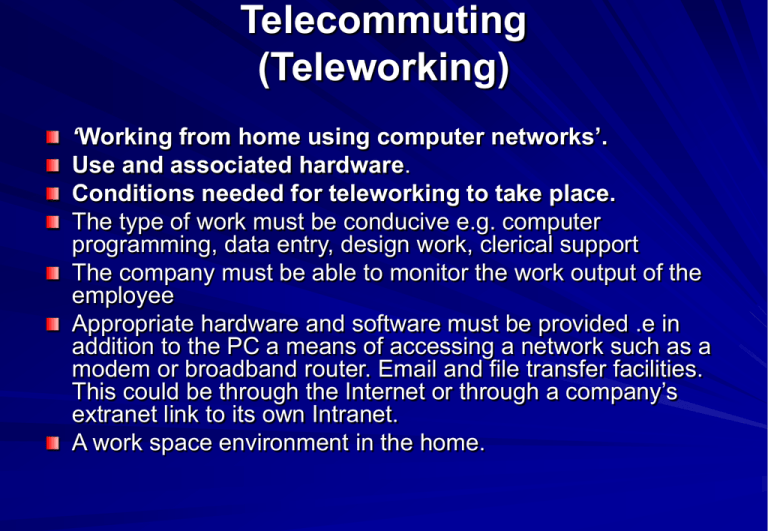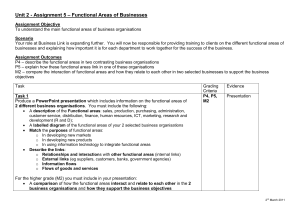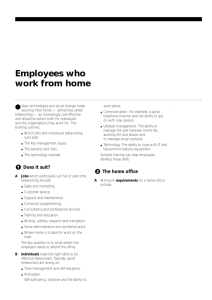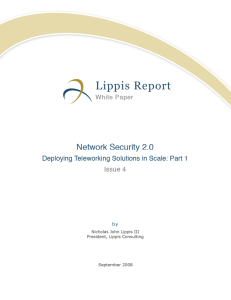Working with ICT
advertisement

Telecommuting (Teleworking) ‘Working from home using computer networks’. Use and associated hardware. Conditions needed for teleworking to take place. The type of work must be conducive e.g. computer programming, data entry, design work, clerical support The company must be able to monitor the work output of the employee Appropriate hardware and software must be provided .e in addition to the PC a means of accessing a network such as a modem or broadband router. Email and file transfer facilities. This could be through the Internet or through a company’s extranet link to its own Intranet. A work space environment in the home. Advantages to employees Savings in journey to work time and travel cost More flexible working hours especially for worker with young children Working in a known environment. Some people feel quieter, safer, more creative Advantages for the Employer Improved retention of employees - for example, teleworking can help retain working parents with childcare responsibilities a wider pool of applicants from which to recruit - for example, disabled people who may prefer to work from home possible productivity gains through staff having fewer interruptions and less commuting time increased staff motivation with reduced stress and sickness levels Cut down on absences due to babysitting problems savings on office space and other facilities possible location of sales staff near clients rather than being based in your premises Hiring on short term basis of productivity or hire only when needed e.g. processing orders in a batch processing system Disadvantages of teleworking for the employee Social isolation - loss of personal contact with colleagues Never get to ‘leave the working environment’ Disadvantages for the employer Difficulties in monitoring productivity and managing homeworkers and monitoring performance initial costs of training and providing suitable equipment, including adaptations to meet health and safety standards and the needs of disabled employees More difficulty of maintaining staff development and upgrading skills and therefore a possible deterioration in employees' skills and work quality Security issues in transferring data electronically across the Internet/extranet increased telecommunications costs risk of communication problems can be harder to maintain team spirit working from home is unsuitable for certain types of job A shift towards homeworking doesn't mean employees have to work only at home. Often splitting time between home and the workplace is the most productive solution and you may want the homeworker to attend meetings to keep them fully involved and informed. Video Conferencing (Tele-conferencing). With a small video camera fixed to your microcomputer, your image can be sent down the network to another user (and vice versa). Digital cameras send digital images and Audio signals are picked up by a microphone and are also sent. This means you can see and talk to another user. Companies can set up meetings with face to face communication between people who are not in the same room, building or even country! Advantages Video conferencing allows regular meeting to take place between employees or companies located in different places. Employees especially those abroad can get together for regular meetings without wasting time and money travelling In conjunction with the Internet it can facilitate presentations. e.g. An employee can create a presentation which is viewed by others in other locations perhaps using the companies website Disadvantages Cost of setting up a videoconferencing room and purchase and maintenance of hardware Subtle communications between people e.g. face and body language can be lost because not picked up by cameras and microphones or lost on the compression of data when being sent. Technical, compression and signal problems can occur. Pictures are a bit 'jittery' at the moment but advancing technology such as fast broadband connection will improve quality of pictures Codes of Conduct What is a Code of Conduct? It is an undertaking by an employee to follow the rules of the company and work within the specific guidelines set out. The code of conduct will set out what is expected of an employee and set out the disciplinary policy o=if those rules are broken. Employees are normally expected to sign the code of conduct as part of their employment contract. Why do we need a Code of Conduct? Problems that could arise. Introduction of viruses e.g. by downloading illicit software or careless opening of emails Abusive emails to colleagues Distribution of material of a sexually or racially offensive nature. Use of company data for illicit purposes e.g. Blackmail, computer fraud or selling to other organisations. Violating terms of copyright or software agreements by copying software Misuse of company equipment e.g. using company time for personal email; using company printers for personal work; using the Internet and running up telephone bills for own purposes; inappropriate use of mobiles phones – in restaurants, schools, public transport How to prevent these problems Problem Viruses Abusive email Prevention Ban use of outside discs and automatically scan all emails or downloaded files. Instruct staff not to open unsolicited emails Respecting rights of others Penalties for misuse include; informal warnings written warnings dismissal prosecution Violating terms of copyright or software agreements by copying software Abiding by current legislation abide by any relevant legislation e.g. Data Protection Act, Equal Opportunities Act, Computer Misuse Act, Copyright Act etc Complying with licensing agreements Use of company data Authorisation and permissions on for illicit purposes data access: what the employee e.g. Blackmail, can and can’t do to data computer fraud or Security: don’t disclose passwords, selling to other personal use of email logging on and organisations. off procedures, encryption of transferred data etc. Misuse of company Protecting hardware and equipment e.g. using software from malicious company time for personal damage email; using company printers for personal work; using the Internet and running up telephone bills for own purposes; inappropriate use of mobiles phones – in restaurants, schools, public transport The code of conduct will set out what is expected of an employee and set out the disciplinary policy if those rules are broken. Employees are normally expected to sign the code of conduct as part of their employment contract. It will set out; Responsibilities ( abide by company rules ) Respecting rights of others Abiding by current legislation Authorisation and permissions on data access: Security: Protecting hardware and software from malicious damage Complying with licensing agreements Penalties – – – – – Penalties for misuse include; informal warnings written warnings dismissal prosecution Codes of Conduct in the Workplace Moral, Social and Ethics NOT on THE INTERNET 1. Disinformation Not fully informing potential customers or clients of all available facts concerning products or services e.g. imminent introduction of new models. Disinformation Examples Estate Agent Legal requirements Moral example = Properties Act = A property developer not telling his client the property has subsidence problems or a violent history. For a hospital treating a patient; Legal requirements Moral example = Data Protection Act = Response times might be part of the code of practise Hardware & software sales ; Legal requirements Moral example = Trades Descriptions Act = prohibit salespersons from selling hardware and software soon to become obsolete = ensure salesmen do not pressurise unwilling customers to accept e.g. loyalty cards , in store credit accounts or particular brands. 2. Privacy Informing data subjects of their legal rights and processes for complying with those rights. ICT systems have enabled many organisations to hold data on the public. People are not always aware of their rights under data protection legislation and not all organisations are ethical in their use of this data. Legal requirements = Data Protection Act Ethics = An employee using company data to create mailing lists for his own private home business Monitoring company emails. Electronic monitoring systems can be used to track emails. A systems technician might open other people’s emails to detect misuse or simple to be nosey 3. Employment patterns Effects upon the workforce. Some people have been de-skilled by the arrival of ICT and their skills are no longer required and they loose their jobs Call centres have caused many people to lose jobs as they have been moved abroad where labour is cheaper leading to ICT ‘sweat shops’. Others have gained and have the required skills e.g. computer programmers. Personal empowerment. There have been changes in working patterns e.g. teleworking Businesses are able to reach a wider market via the Internet Individuals can sell goods on Ebay Health and Safety at Work Act governs working conditions using computer systems – do companies provide these for teleworkers Disability Rights Act deals with the rights of disabled people and their access to work – do companies have stairs or other facilities which restrict disabled people in wheelchairs from getting jobs in the company? Minimum Wage Contracts – illegal immigrants working below the minimum wage Ethics : not complying with these and many other employment laws to provide unsafe or poor access to computer systems Hazard Prevention RSI repetitive strain injury caused by prolonged working at computers or computer games Ergonomic keyboards ; wrist and foot supports: correct chair positioning Eye Strain and epileptic fits Non flickering screens; Screen filters t remove glare; correct lighting in the room Back problems Adjustable chairs; foot supports:; tilting screens Ozone irritation from laser printers Locate personal laser printer 1 metre away from user Radiation affects embryos leading to miscarriages No real evidence for this 4. Equity Legal requirement Patent laws / Data Protection Act Moral Example Ownership and access to information can often determine which organisations will be successful and which will fail. As these technologies have to be paid for the richer organisations can afford the technology whilst poorer organisation cannot. Consequentially, the rich organisations get richer and the poorer ones get relatively poorer and the gap between them gets greater. 5. Intellectual property rights- Ownership rights to data. If you put a joke on the Internet do you own it? If you see a joke on the Internet can you sell that joke to a professional comedian? If you scan in the text of the book ‘The Da Vinci Code’ and put it on the Internet for all to be freely read; are you breaking the law? Can you sue someone who sells you an essay which is full of factual errors? The growth and exchange of ideas on the Internet has led to many legal disputes and lack of legal clarity as to ones intellectual property rights. Do the Copyright Laws of one country apply to another country? Intellectual property rights Legal Requirements Copyright Laws / Patent laws Moral examples If you put a idea on the Internet do you own it? If you see a design on the Internet can you sell that design to a company? If you scan in the text of the book and put it on the Internet for all to be freely read; are you breaking the law? Can you sue someone in another continent who sells you a report on you which is full of factual errors?





